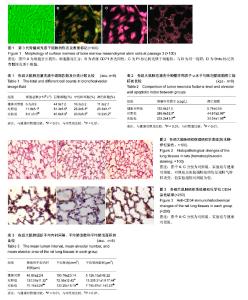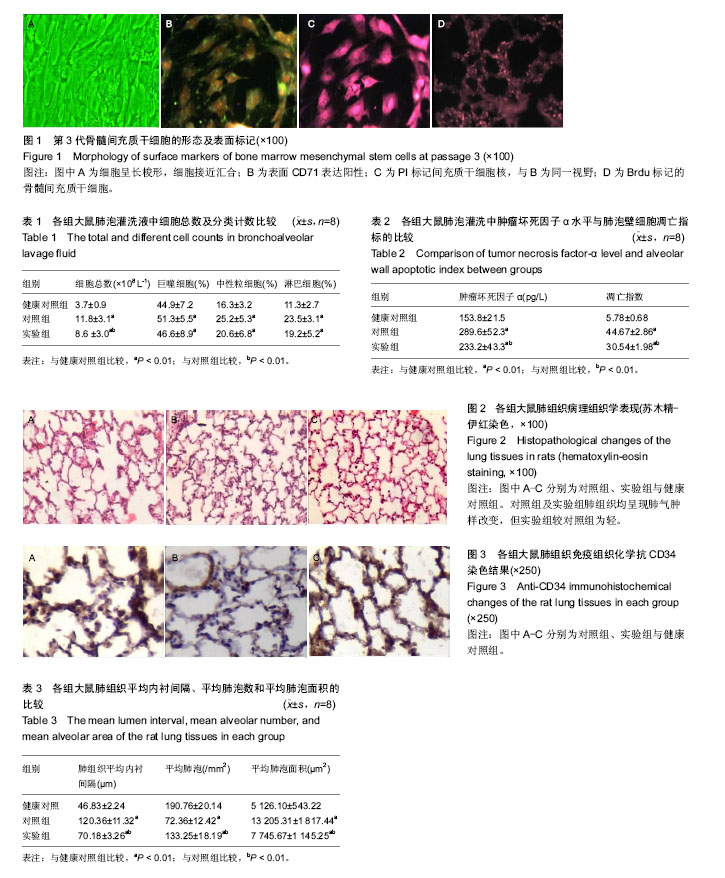| [1] Lea SR,Metcalfe HJ,Plumb J,et al.Neutral sphingomyelinase-2, acid sphingomyelinase, and ceramide levels in COPD patients compared to controls.Int J Chron Obstruct Pulmon Dis.2016;11:2139-2147.[2] Khakban A,Sin DD,FitzGerald JM,et al.The Projected Epidemic of COPD Hospitalizations Over the Next 15 Years: A Population Based Perspective.Am J Respir Crit Care Med. 2017;195(3):287-291.[3] Zhao Y,Cui A,Wang F,et al.Characteristics of pulmonary inflammation in combined pulmonary fibrosis and emphysema.Chin Med J(Engl).2012;125(17):3015-3021.[4] Tanabe N,Muro S,Tanaka S,et al.Emphysema distribution and annual changes in pulmonary function in male patients with chronic obstructive pulmonary disease.Respir Res.2012; 13:31.[5] Li BP,Zhao XJ,Song YM,et al.Restoration of pathological changes of emphysema by angiogenesis factors: experiment of rats.Zhonghua Yi Xue Za Zhi.2007;87(33):2365-2368.[6] Cyranoski D.Stem cells in Texas: Cowboy culture.Nature. 2013;494(7436):166-168.[7] Vincent LG,Engler AJ.Stem cell differentiation: Post-degradation forces kick in. Nat Mater.2013;12(5): 384-386.[8] Román F,Urra C,Porras O,et al.Real-Time H2O2 Measurements in Bone Marrow Mesenchymal Stem Cells (MSCs) Show Increased Antioxidant Capacity in Cells from Osteoporotic Women.J Cell Biochem.2017;118(3):585-593.[9] 李宝平,赵晓建,宋永明,等.血管生成因子修复肺气肿病变的实验研究[J].中华医学杂志,2007,87(33):2365-2368.[10] Jacobs SA,Roobrouck VD,Verfaillie CM,et al.Immunological characteristics of human mesenchymal stem cells and multipotent adult progenitor cells.Immunol Cell Biol. 2013; 91(1):32-39.[11] Kennedy GJ.Behavioral Interventions for Patients with Major Depression and Severe COPD.Am J Geriatr Psychiatry. 2016;24(11):975-976.[12] Bøgelund M,Hagelund L,Asmussen MB.COPD-treating Nurses' Preferences for Inhaler Attributes - a Discrete Choice Experiment.Curr Med Res Opin.2017;33(1):71-75.[13] Kobayashi S,Hanagama M,Yamanda S,et al.Inflammatory biomarkers in asthma-COPD overlap syndrome.Int J Chron Obstruct Pulmon Dis.2016;11:2117-2123.[14] Nishio M,Nakane K,Tanaka Y.Application of the homology method for quantification of low-attenuation lung region inpatients with and without COPD.Int J Chron Obstruct Pulmon Dis.2016;11:2125-2137.[15] Morris NR,Walsh J,Adams L,et al.Exercise training in COPD: What is it about intensity. Respirology.2016;21(7):1185-1192.[16] Erdal M,Johannessen A,Eagan TMet al.Incidence of utilization- and symptom-defined COPD exacerbations in hospital- and population-recruited patients.Int J Chron Obstruct Pulmon Dis.2016;11:2099-2108.[17] Miravitlles M,Chapman KR,Chuecos F,et al.The efficacy of aclidinium/formoterol on lung function and symptoms in patients with COPD categorized by symptom status: a pooled analysis.Int J Chron Obstruct Pulmon Dis. 2016;11: 2041-2053.[18] Choudhury G,MacNee W.Role of Inflammation and Oxidative Stress in the Pathology of Ageing in COPD: Potential Therapeutic Interventions.COPD.2017;14(1):122-135. [19] ]Malih S,Saidijam M,Mansouri K,et al.Promigratory and proangiogenic effects of AdipoRon on bone marrow-derived mesenchymal stem cells: an in vitro study.Biotechnol Lett. 2017;39(1):39-44.[20] Guo Q,Chen Y,Guo L,et al.miR-23a/b regulates the balance between osteoblast and adipocyte differentiation in bone marrow mesenchymal stem cells.Bone Res.2016;4:16022.[21] Ren M,Wang T,Huang L,et al.Role of VR1 in the differentiation of bone marrow-derived mesenchymal stem cells into cardiomyocytes associated with Wnt/β-catenin signaling. Cardiovasc Ther.2016;34(6):482-488. [22] Chehelcheraghi F,Eimani H,Homayoonsadraie S,et al.Effects of Acellular Amniotic Membrane Matrix and Bone Marrow-Derived Mesenchymal Stem Cells in Improving Random Skin Flap Survival in Rats.Iran Red Crescent Med J.2016;18(6):e25588.[23] Hao Y,Geng L.Administration of bone marrow mesenchymal stem cells attenuates inflammation of rats with sepsis.Xi Bao Yu Fen Zi Mian Yi Xue Za Zhi.2016; 32(9):1158-1163.[24] Pérez-Serrano RM,González-Dávalos ML,Lozano-Flores C,et al.PPAR Agonists Promote the Differentiation of Porcine Bone Marrow Mesenchymal Stem Cells into the Adipogenic and Myogenic Lineages.Cells Tissues Organs.2016.[Epub ahead of print][25] Zhang J,Shao Y,He D,et al.Evidence that bone marrow-derived mesenchymal stem cells reduce epithelial permeability following phosgene-induced acute lung injury via activation of wnt3a protein-induced canonical wnt/β-catenin signaling.Inhal Toxicol.2016;28(12):572-579. [26] Chen J,Ma G,Liu W,et al.The influence of the sensory neurotransmitter calcitonin gene-related peptide on bone marrow mesenchymal stem cells from ovariectomized rats.J Bone Miner Metab.2016.[Epub ahead of print][27] Cao J,Hou S,Ding H,et al.In Vivo Tracking of Systemically Administered Allogeneic Bone Marrow Mesenchymal Stem Cells in Normal Rats through Bioluminescence Imaging.Stem Cells Int.2016;2016:3970942.[28] Gong M,Antony S,Sakurai R,et al.Bone marrow mesenchymal stem cells of the intrauterine growth restricted rat offspring exhibit enhanced adipogenic phenotype. Int J Obes (Lond).2016;40(11):1768-1775. [29] Roger Y,Schäck LM,Koroleva A,et al.Grid-like surface structures in thermoplastic polyurethane induce anti-inflammatory and anti-fibrotic processes in bone marrow-derived mesenchymal stem cells.Colloids Surf B Biointerfaces.2016;148: 104-115.[30] Fu WM,Yang L,Wang BJ,et al.Porous tantalum seeded with bone marrow mesenchymal stem cells attenuates steroid-associated osteonecrosis.Eur Rev Med Pharmacol Sci.2016; 20(16):3490-3499.[31] Dos SGG,Batool S,Hastreiter A,et al.The influence of protein malnutrition on biological and immunomodulatory aspects of bone marrow mesenchymal stem cells.Clin Nutr. 2016.pii: S0261-5614(16)30202-3.doi:10.1016/j.clnu.2016.08.005.[Epub ahead of print] |

